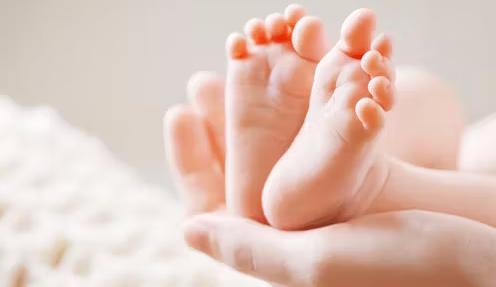More secure jobs and higher unemployment benefits would help lift Australia’s birth rate
- Written by Irma Mooi-Reci, Professor in Labour Sociology, The University of Melbourne

Across developed countries, including Australia, fewer babies are being born.
In 2023, 289,100 babies were born in Australia, a big drop from the 2021 post-lockdown spike during which there was 315,200 births, an analysis[1] by KPMG has found.
Among the different explanations for this trend, employment insecurity[2] looms large.
A major concern[3] is many young people are in casual jobs or on part-time contracts.
These so-called non-standard employment arrangements, and especially casual work, are strongly tied with job insecurity, unpredictable[4] working hours and fluctuating pay, making it difficult for people to commit to starting a family.
In Australia, more than 40% of all employment over the past two decades (2001-2022) has been engaged in non-standard work. The Household, Income and Labour Dynamics in Australia [5](HILDA) Survey found about 19% of workers did casual hours over the past two decades.
What we know about casual workers and their desire to have children?
Internationally[6], and in Australia[7] studies show a strong correlation between casual work and lower fertility.
However, it is unclear if temporary or casual work leads to fewer children, or if people who want fewer children are more likely to choose temporary or casual jobs.
This is what we wanted to find out in our study[8] based on an analysis of 19 years of data from the HILDA Survey. We make two key observations:
-
working in temporary and casual jobs was linked with a lower desire to have children, particularly among men. This was nearly twice as strong for men in temporary jobs than those in casual roles
-
there was great variation in the desire to have children across different groups.
For example, well-educated and high-income men in temporary jobs were the least likely to plan on starting a family.
Conversely, casual work had a more significant negative impact on the desire to have children among men with limited education, low income, and low-status positions.
These findings suggest having a job with no guarantee of continuity reduces people’s plans to have a baby.
So, why do workers with irregular pay have fewer babies?
Lower earnings are part of the answer. In a study[9] published earlier this year, we showed women in casual jobs earn lower wages often because they are working fewer hours than they would actually prefer.
Indeed, underemployment[10] is common among Australian women in casual jobs and is coupled with lower pay.
And as women look for jobs with longer hours and better pay or take on second jobs, their plans to start a family and have children are not just delayed but often abandoned.
Another part of the answer is job insecurity. Women in casual and temporary jobs often feel less secure and worry about losing their jobs, making them less inclined to have children.
Moving in and out of employment often comes with a big drop[11] in income. This is because Australia’s unemployment payments[12] cover only a small percentage of a worker’s previous wages and are ranked amongst the lowest[13] in OECD countries.
In fact, in Australia, income drops during unemployment can be so high that they can push families into poverty[15].
This situation makes it hard, especially for those with insecure work – to cover basic needs and create a safe, healthy environment, let alone raise children.
How can we boost the birth rate?
While cutting down on temporary and casual jobs in Australia may sound like a solution, it won’t solve the problem of fewer births. In fact, it could hurt the economy by making it harder for employers to create new jobs.
Instead, the fertility problem could be fixed by:
Creating more secure full-time jobs. We found casual workers earn less because they often work fewer hours and are underemployed. This limits opportunities to start a family. Creating more full-time, secure jobs with career growth opportunities is crucial.
Reducing the real costs of job loss. Australia’s unemployment support system offers minimal financial support and few incentives to find work. An insurance-based benefit system could fix this, reducing the actual costs of unemployment and worries about future job loss.
In most OECD countries, insurance-based unemployment benefits[16] are funded by contributions from employers and employees, similar to Australia’s superannuation system.
When people lose their jobs, these benefits replace a portion of their lost wages for a limited time. An unemployment insurance system offers three key advantages over Australia’s current unemployment payments:
-
it provides more[17] generous and personalised payments than the current JobSeeker payments
-
it encourages workforce participation by giving all workers, including those in part-time, temporary or casual jobs, the opportunity to save and transfer unused benefits for future periods of unemployment
-
it improves job matching and reduces underemployment by giving people the financial means to find jobs matching their skills and preferred hours without immediate financial pressure.
The Albanese government’s Economic Inclusion Advisory Committee[18] has already recommended boosting current unemployment payments.
However, more significant reforms are needed to future-proof the unemployment benefit system. Creating more secure full-time jobs and lowering the costs of job loss would help increase the birth rate.
References
- ^ analysis (kpmg.com)
- ^ insecurity (pubmed.ncbi.nlm.nih.gov)
- ^ concern (www.sciencedirect.com)
- ^ unpredictable (www.tandfonline.com)
- ^ Household, Income and Labour Dynamics in Australia (melbourneinstitute.unimelb.edu.au)
- ^ Internationally (read.dukeupress.edu)
- ^ Australia (link.springer.com)
- ^ study (academic.oup.com)
- ^ study (melbourneinstitute.unimelb.edu.au)
- ^ underemployment (journals.sagepub.com)
- ^ big drop (www.oecd.org)
- ^ Australia’s unemployment payments (www.servicesaustralia.gov.au)
- ^ lowest (data.oecd.org)
- ^ Scott Barbour/AAP (photos.aap.com.au)
- ^ poverty (www.theguardian.com)
- ^ insurance-based unemployment benefits (www.bruegel.org)
- ^ more (www.oecd-ilibrary.org)
- ^ Economic Inclusion Advisory Committee (www.dss.gov.au)


















